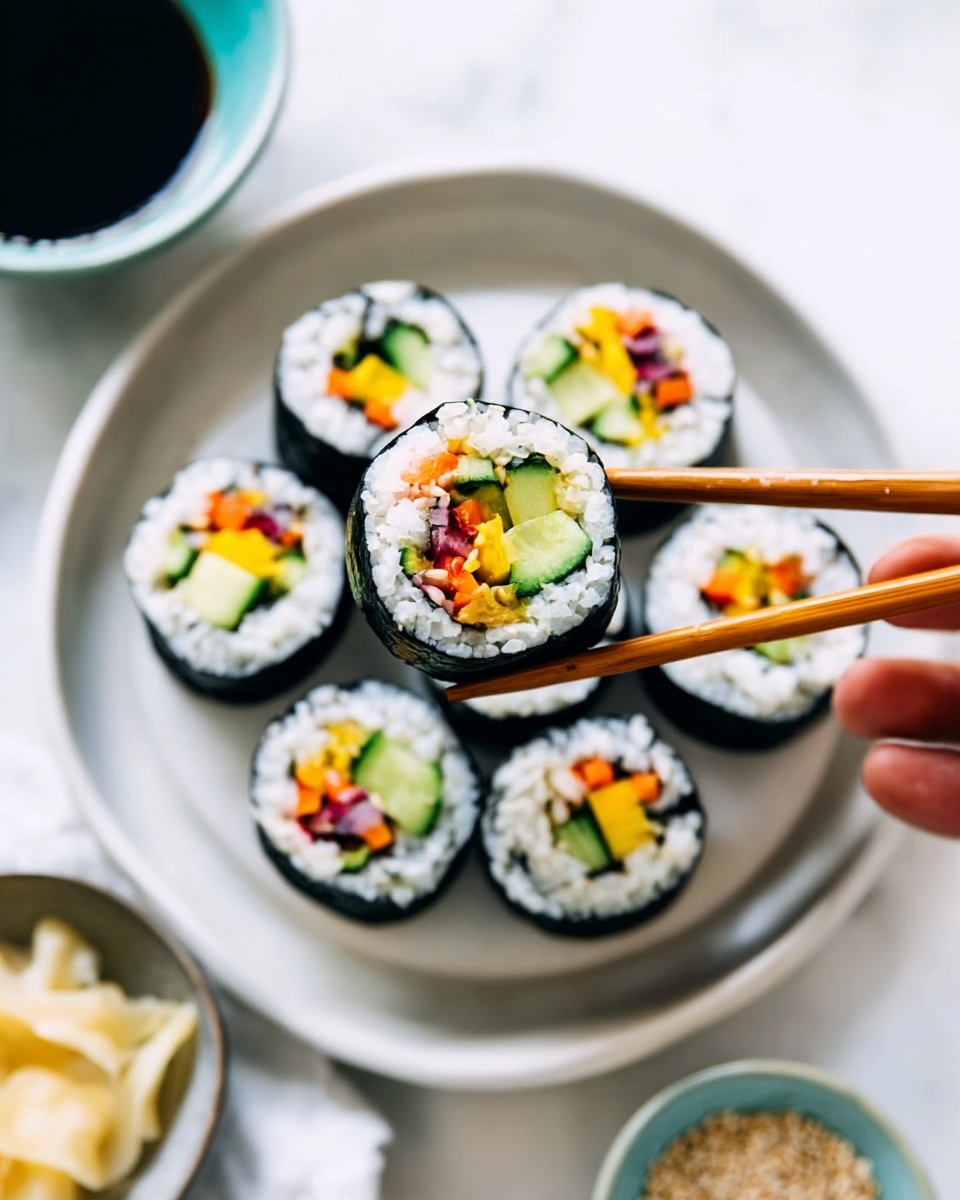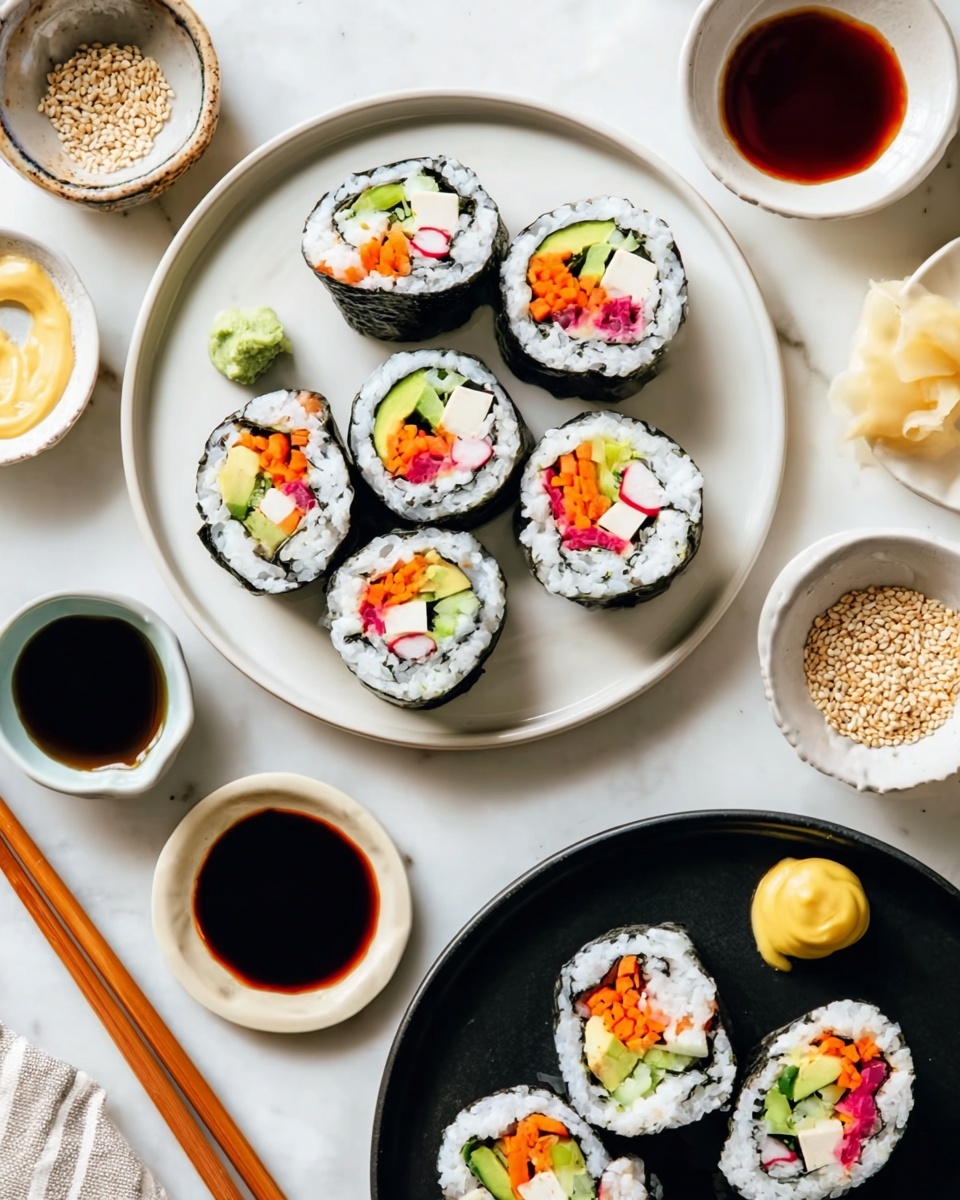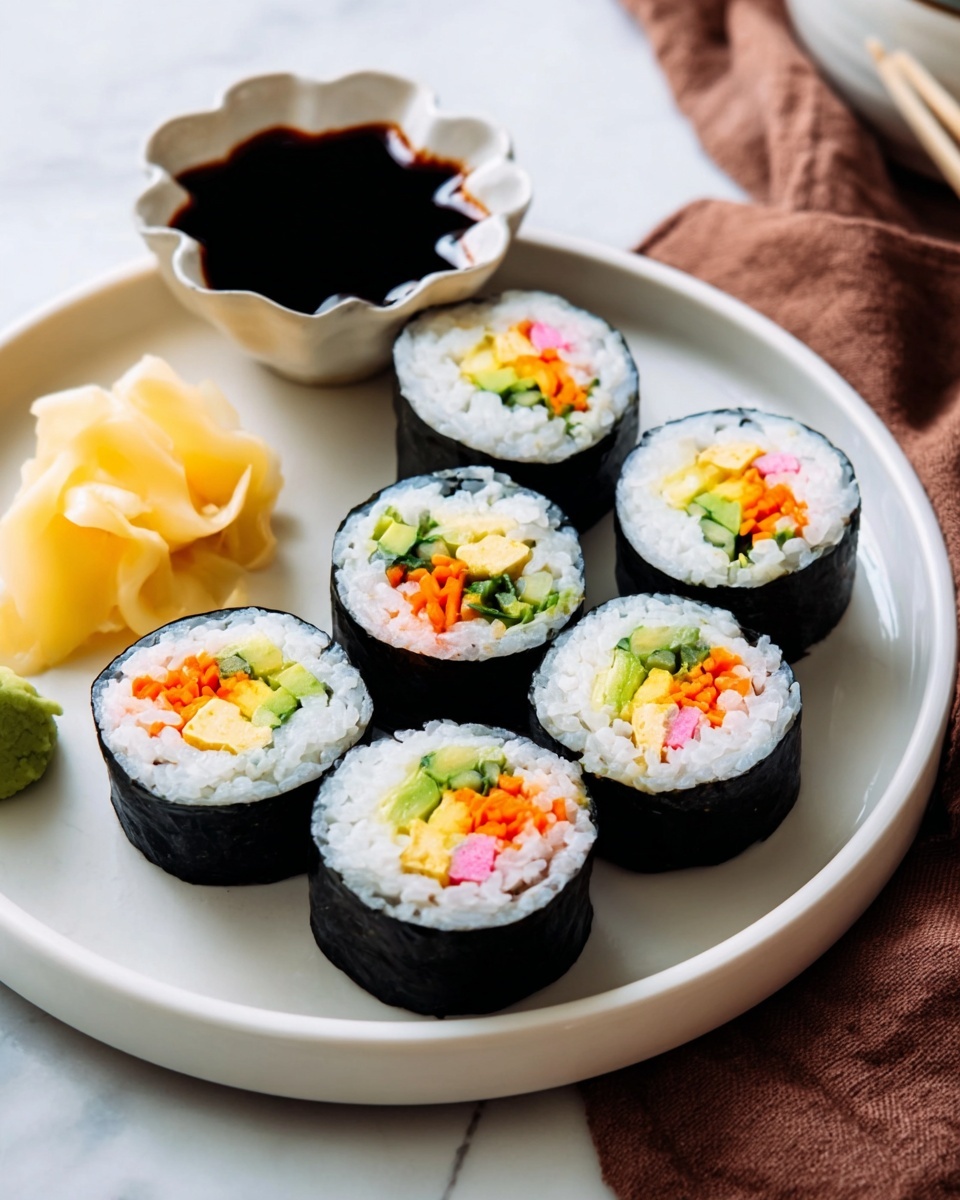If you love sushi but want a fresh, vibrant twist, then you’re going to adore this Vegetarian Sushi Rolls Recipe. It’s packed with crisp veggies, creamy avocado, and that perfect hint of spice from the mayo. I absolutely love how these rolls come together: they’re colorful, satisfying, and surprisingly easy to make at home—even if you’re new to sushi rolling. Stick with me, and I’ll guide you through every step so your sushi rolls turn out perfect every time.
Why You’ll Love This Recipe
- Fresh and Vibrant: The combination of cucumber, carrot, avocado, and tofu gives every bite a fresh, crunchy, and creamy texture.
- Beginner-Friendly: Even if you’ve never made sushi before, my step-by-step tips will have you rolling masterpieces in no time.
- Customizable Fillings: You can easily swap or add vegetables depending on your preference or seasonality.
- Perfect Party Food: These rolls look stunning on a platter and always impress guests with their balance of flavors.
Ingredients You’ll Need
This Vegetarian Sushi Rolls Recipe is all about simple ingredients that pack a punch when combined. The sushi rice is the star here, so investing in good quality Japanese short-grain rice will make all the difference. Fresh vegetables and quality tofu complete the fresh filling.
- Japanese short-grain white rice: Essential for that sticky, clingy texture that holds sushi rolls together perfectly.
- Seasoned rice vinegar (sushi vinegar): Adds a subtle tang and sweetness to the rice—don’t skip it!
- Kombu (dried kelp): Optional, but it infuses a subtle umami aroma to the rice if you use it.
- Red onion: Pickled to add a bright, sharp contrast to the creamy avocado.
- Japanese Kewpie mayonnaise: Creamy and mellow, mixed with sriracha for a spicy kick, this spicy mayo makes the rolls pop.
- Cucumbers: I prefer Japanese or Persian cucumbers for their thin skin and fewer seeds.
- Carrot: Adds crunch and natural sweetness.
- Deep-fried firm tofu cutlet (atsuage): Gives the rolls a satisfying chew and protein boost.
- Avocados: The creamy element that pairs wonderfully with crisp veggies and spicy mayo.
- Nori sheets (dried laver seaweed): The classic sushi wrapper, use fresh sheets for best results.
Variations
I love experimenting with this Vegetarian Sushi Rolls Recipe by switching up the fillings to keep things fresh and suit whatever cravings I have or what’s in my fridge. Feel free to get creative!
- Swap the Tofu: I’ve tried marinated tempeh or grilled eggplant instead, and both brought lovely depth and texture.
- Add Crunch: Fresh snap peas or thinly sliced radishes create an extra crisp bite that my family can’t get enough of.
- Make it Vegan: Just use vegan mayo instead of Kewpie mayo, and skip any honey or fish-based vinegar if your sushi vinegar isn’t vegan.
- Seasonal Veggies: Try roasted sweet potatoes or asparagus spears for a seasonal twist that’s just as tasty.
How to Make Vegetarian Sushi Rolls Recipe
Step 1: Perfect Your Sushi Rice
The key to any great sushi roll is the rice, and trust me, this is where many beginners stumble. I always rinse the Japanese short-grain rice until the water runs almost clear—this removes excess starch and prevents mushy rice. Then I soak it for about 20–30 minutes with the kombu piece (if you’re using it) to infuse that subtle umami flavor. Cooking it in a rice cooker with a water ratio of 1:1 makes it slightly firm—just right for sushi.
Once the rice is cooked, toss out the kombu, transfer the hot rice to a wooden sushi oke or a large container, and gently fold in the seasoned rice vinegar using a slicing motion. I learned that stirring or mixing too vigorously breaks the grains and turns your rice sticky and mushy—something you definitely want to avoid. While mixing, fan the rice to cool it down quickly; this helps it shine and keeps it from getting soggy. Cover the rice with a damp cloth at room temperature until you’re ready to roll.
Step 2: Prepare Your Fresh and Pickled Veggies
While your rice cooks and cools, thinly slice half a red onion and soak it in seasoned rice vinegar to pickle—this adds a contrasty tangy crunch that brightens the roll. Then slice cucumbers lengthwise, removing seeds to avoid extra moisture—this was a trick I discovered that keeps rolls from getting soggy inside!
Next, peel and julienne the carrot with either a specialized peeler or a knife for super-thin strips, and cut the deep-fried tofu cutlet into long sticks that fit nicely into your rolls. For the avocados, I like to slice them carefully, then spritz with lime juice to keep them from browning. Handling the avocado pit can be intimidating, but I found gently tapping the knife into the pit and twisting it out works beautifully—just watch your fingers!
Step 3: Roll It Up Carefully
Place a nori sheet shiny side down on your bamboo rolling mat, then spread about 1 cup of sushi rice evenly over the sheet, leaving a half-inch strip at the top free of rice. I wet my fingers with water now and then to keep the rice from sticking—this little trick really helped my first rolls turn out neat.
Spoon a thin line of spicy mayo about 1½ inches from the bottom edge, then lay your cucumber strips, avocado slices, tofu sticks, pickled red onion, and carrot neatly on top. Beginners should place the filling a little higher up (around the one-third mark from the bottom) to make rolling easier and avoid overstuffing, which can cause the roll to burst open.
Now the fun part: lift the edge of your bamboo mat closest to you and begin rolling away from you tightly and firmly, keeping the ingredients compact as you go. Use your fingers to gently press and hold the fillings in place. Once rolled, squeeze the mat around the roll firmly to seal it and compress everything into a tidy cylinder. Cover the finished rolls with plastic wrap to keep the nori from drying out while you finish the rest.
Step 4: Slice Your Rolls Like a Pro
Use a very sharp knife to cut your rolls cleanly. First, cut each roll in half, wiping the blade with a wet cloth between cuts so the rice doesn’t stick to the knife. Then cut each half into quarters, and finally into eighths—this creates bite-sized pieces that are easy to enjoy. The first time I made these, I struggled with the rice sticking to my knife, but cleaning the blade after each cut solved that completely.
Pro Tips for Making Vegetarian Sushi Rolls Recipe
- Rice Moisture Balance: Cooking sushi rice slightly firm keeps your rolls from turning mushy—use a 1:1 rice to water ratio.
- Fanning is Key: Fanning the rice while folding in vinegar cools it quickly and helps grains stay shiny and separate.
- Keep Hands Wet: Wet your hands or spoon to prevent rice from sticking when spreading it on nori sheets.
- Clean the Knife Often: Wiping your knife between cuts prevents squashed rolls and messy edges.
How to Serve Vegetarian Sushi Rolls Recipe

Garnishes
I like to add simple but eye-catching garnishes like a sprinkle of toasted sesame seeds or thinly sliced green onions. A small dollop of wasabi and some pickled ginger on the side add that traditional zing and palate cleanser that bring the whole experience alive. Plus, a little drizzle of soy sauce for dipping—just enough to enhance without overpowering the delicate flavors inside.
Side Dishes
Pair your Vegetarian Sushi Rolls with miso soup or a bright seaweed salad for a balanced meal. I’ve also served them alongside edamame sprinkled with coarse sea salt for a playful side that’s fun to munch on while waiting for the rolls to disappear.
Creative Ways to Present
For special occasions, I like to arrange the sushi rolls in a colorful spiral or checkerboard pattern on a large platter. Adding edible flowers or thin cucumber ribbons alongside the rolls elevates the presentation for guests. Another fun idea is to cut the rolls slightly thicker and serve with bamboo skewers for easy party bites.
Make Ahead and Storage
Storing Leftovers
If you have leftover sushi rolls, keep them wrapped in plastic wrap and store in a cool spot for up to 8 hours; try to eat them the same day for best freshness. For overnight storage, I cover them loosely with a thick kitchen towel at room temperature to prevent the rice from becoming hard but avoid refrigeration as it dries sushi rice out quickly.
Freezing
Freezing sushi rolls isn’t usually recommended because the texture of the rice and avocado changes, but you can freeze leftover cooked sushi rice separately for up to a month. I defrost it overnight in the fridge and gently microwave it to room temperature before rolling fresh sushi later.
Reheating
Reheat leftover sushi rice (not the rolls) by covering it lightly and microwaving in short bursts, stirring in between to avoid hot spots. For sushi rolls, I recommend enjoying them fresh, but if needed, let them come to room temperature before serving to bring back some of their original texture.
FAQs
-
Can I use regular rice instead of Japanese short-grain rice for this Vegetarian Sushi Rolls Recipe?
While you can try, I highly recommend sticking to Japanese short-grain rice for sushi because of its sticky texture that holds the roll together. Regular long-grain rice tends to be too dry and loose, making your sushi fall apart easily.
-
Is there a vegan alternative to the spicy mayo?
Absolutely! Simply swap Japanese Kewpie mayonnaise with your favorite vegan mayo and mix it with sriracha and lime juice just as you would. The flavor is just as delicious and perfect for vegan sushi rolls.
-
How do I prevent the avocado from browning in the sushi rolls?
Sprinkle or brush a splash of fresh lime or lemon juice over the sliced avocado before adding it to the roll. The citrus slows oxidation and keeps the avocado looking fresh and green.
-
Can I prepare these vegetarian sushi rolls in advance for a party?
You can prep all the ingredients and sushi rice in advance, but I recommend assembling and rolling the sushi as close to serving time as possible to keep the nori crisp and the rice at the perfect texture. If you must make them earlier, wrap tightly in plastic and keep at cool room temperature.
Final Thoughts
This Vegetarian Sushi Rolls Recipe has truly become a favorite in my kitchen—I love how approachable it is, with flavors and textures that please everyone at the table. There’s something so satisfying about rolling your own sushi and customizing the fillings just the way you like. I hope you give it a try and enjoy the process as much as the delicious end result. Grab your bamboo mat, get those hands wet, and let’s roll some spectacular veggie sushi together!
Print
Vegetarian Sushi Rolls Recipe
- Prep Time: 45 minutes
- Cook Time: 1 hour
- Total Time: 1 hour 45 minutes
- Yield: 6 sushi rolls
- Category: Sushi
- Method: Stovetop
- Cuisine: Japanese
- Diet: Vegetarian
Description
These Vegetarian Sushi Rolls feature perfectly seasoned sushi rice combined with fresh cucumber, carrot, creamy avocado, marinated tofu, and tangy pickled red onion, all wrapped in nori sheets and enhanced with a spicy mayo drizzle. This recipe guides you through making authentic sushi rice, assembling the rolls, and tips for perfect slicing and storage, resulting in a vibrant, wholesome sushi experience that’s ideal for a satisfying meat-free meal.
Ingredients
For the Sushi Rice
- 2¼ cups uncooked Japanese short-grain white rice (3 rice cooker cups; 540 ml; yields 6⅔ cups (990 g) cooked rice)
- 2¼ cups water (540 ml)
- 1 piece kombu (dried kelp) (5 g; 2″x 2″; optional)
- ⅓ cup seasoned rice vinegar (sushi vinegar)
For the Pickled Red Onion
- ½ red onion
- ½ cup seasoned rice vinegar (sushi vinegar)
For the Spicy Mayo
- ¼ cup Japanese Kewpie mayonnaise (or vegan mayonnaise for vegan option)
- 1 Tbsp sriracha sauce
- splash lime juice
For the Sushi Rolls
- 2 Japanese or Persian cucumbers
- 1 carrot
- 1 deep-fried firm tofu cutlet (atsuage)
- 2 avocados
- splash lime juice
- 6 sheets nori (dried laver seaweed)
Instructions
- Prepare Sushi Rice: Rinse the uncooked Japanese short-grain rice until water runs almost clear. Place rice in rice cooker with water and a piece of kombu. Let soak 20–30 minutes, then cook. Discard kombu after cooking.
- Season and Cool Rice: Transfer rice to a wooden sushi oke or lined baking sheet. Pour seasoned rice vinegar over rice while hot. Using a rice paddle, gently slice rice at a 45-degree angle to incorporate vinegar without breaking grains. Fan the rice vigorously while slicing to cool and remove moisture. Cover with damp towel to keep moist.
- Make Pickled Red Onion: Thinly slice red onion, place in jar or bowl, cover with seasoned rice vinegar, and set aside to pickle.
- Make Spicy Mayo: Whisk together Kewpie mayonnaise, sriracha sauce, and a splash of lime juice. Set aside.
- Prep Vegetables and Tofu: Halve cucumbers lengthwise, scoop out seeds, and slice into long strips. Julienne the carrot. Cut fried tofu cutlet into slabs then long sticks.
- Prepare Avocado: Halve and pit avocados carefully. Cut quarters and remove skin. Slice lengthwise and brush with lime juice to prevent browning.
- Assemble Sushi Rolls: Place one nori sheet shiny side down on bamboo rolling mat. Spread 1 cup (150 g) sushi rice evenly, leaving a ½ inch strip at the top edge uncovered. Spread a thin line of spicy mayo about 1½ inches from the bottom edge. Layer cucumber strips, avocado slices, tofu sticks, pickled red onion, and carrot strips evenly across the rice.
- Roll Sushi: Carefully lift the bottom edge of the mat, folding nori over fillings tightly. Continue rolling firmly until roll is sealed. Squeeze bamboo mat to shape sushi tightly. Wrap finished roll with plastic wrap to prevent drying.
- Slice and Serve: Using a very sharp knife, cut sushi roll in half, wiping knife clean with wet cloth between cuts. Then slice halves into quarters, and quarters into halves to yield 8 pieces per roll. Arrange on platter and serve with soy sauce, wasabi, and pickled ginger.
- Storage Tips: Keep leftover sushi rolls in a cool place up to 8 hours. For overnight storage, cover with a thick kitchen towel to keep rice cool but not cold. Leftover sushi rice can be frozen for up to 1 month; thaw overnight in fridge and gently microwave to room temperature before use.
Notes
- Always use Japanese short-grain rice for best sushi texture; other rice types will not hold together well.
- Remove cucumber seeds to avoid excess moisture in rolls causing sogginess.
- Use a bamboo rolling mat and wet your fingers when handling rice to prevent sticking.
- For even slices, clean the sharp knife between cuts with a wet cloth.
- Fanning the rice while mixing vinegar is crucial to shine and texture of sushi rice.
- Kombu is optional but adds a subtle aroma and umami to the rice during cooking.
- For vegan sushi, substitute Kewpie mayonnaise with vegan mayo.
- Do not refrigerate sushi rolls directly as rice hardens; keep cool but not cold for best texture.
Nutrition
- Serving Size: 1 sushi roll
- Calories: 280
- Sugar: 3g
- Sodium: 490mg
- Fat: 12g
- Saturated Fat: 2g
- Unsaturated Fat: 8g
- Trans Fat: 0g
- Carbohydrates: 35g
- Fiber: 5g
- Protein: 7g
- Cholesterol: 0mg



